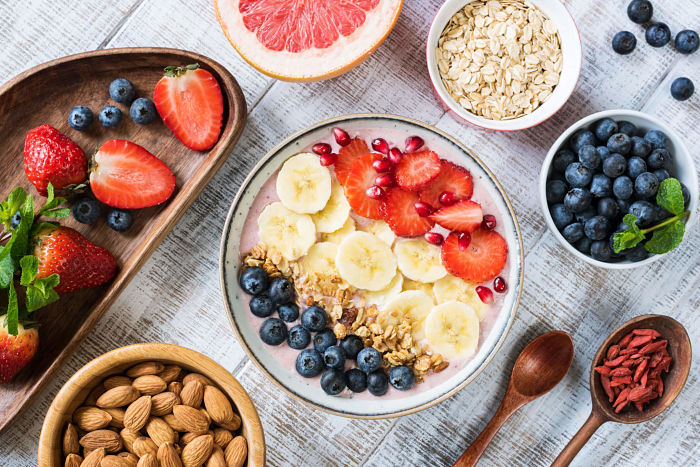Breakfast may be your last priority on your to-do list, or even worse, it may not even be on your list. Having a good healthy breakfast every morning is essential as it recharges your body and prepares you for a good start to the day, and has a variety of health benefits. Never skip this all-important meal.

Here are some simple and flexible options that you can implement to have a quick and easy breakfast in the morning.
The benefits of a healthy breakfast
Breakfast gives you the opportunity to start each day with a healthy and nutritious meal. Adults who report eating a healthy breakfast regularly are more likely to:
- Consume more vitamins and minerals.
- Control your weight.
- Control your blood sugar levels.
- Perform better at work.
Children having a healthy breakfast on a regular basis are more likely to:
- Get the amount of recommended daily nutrients.
- Have a healthy body weight.
- Be able to concentrate.
- Missing fewer days of school.
The basics of a healthy breakfast
What exactly is considered a healthy breakfast? These are the bases to take into account:
- Whole grains. Some examples include whole grain muffins and bagels, hot or cold whole grains, whole grain English muffins, and other whole grain breads.
- Lean protein. These foods include eggs, lean meats, legumes, and nuts.
- Low-fat dairy. Examples are milk, plain or low-sugar yogurts, and low-fat cheeses, such as cottage cheese and plain cheeses.
- Fruits and vegetables. Fresh or frozen fruits and vegetables, 100% natural juices with no added sugar, and fruit and vegetable smoothies.
Together, these food groups provide complex carbohydrates, fiber, protein, and a small amount of fat. This is a combination that provides health benefits and helps you feel satisfied for hours.
Find options from these main groups that suit your tastes and preferences. And try to choose foods from at least three of these four food groups for a complete healthy breakfast.
What to look for in dry cereals?
Cereals can be a very good option: Research indicates that people who eat cereals consume fewer calories for breakfast and are less likely to be overweight than people who eat other foods for breakfast. But not all cereals are the same.
Read the Nutrition Facts label and ingredient list before buying a cereal. And remember that not all cereals have the same serving size. One serving of a cereal can be 1/2 cup, while another can be 1 cup.
The important aspects to take into account when choosing a cereal are:
- Choose cereals with at least 3 grams of fiber in each serving, and if possible, aim for 5 grams per serving or more.
- Focus only on cereals that are for adults, which are often lower in sugar than cereals for children. Avoid cereals that contain sugar at or near the top of the ingredient list. Or they include various types of added sugar, such as high fructose corn syrup, honey, brown sugar, and dextrose.
- Calories If you are counting your calories, choose cereals with fewer calories. It would be best if they have less than 160 calories per serving.
Remember to top your cereal bowl with some sliced fruit and skim or low-fat milk. Or if you have to leave the house, take a piece of fruit, a container of milk or some yogurt with you.
Simple and flexible options for your breakfast
A healthy breakfast doesn’t always have to be part of a traditional breakfast menu.
Healthy breakfast options include:
- Cooked oatmeal topped with dried almonds or cranberries.
- Whole wheat pita bread stuffed with hard-boiled egg and vegetables such as spinach.
- A whole wheat tortilla filled with vegetables, salsa and grated low-fat cheese.
- A fruit smoothie, plain yogurt and a tablespoon of wheat germ
- A whole wheat sandwich with lean meat and low-fat cheese, lettuce, tomato, cucumber, and sweet peppers.
- A torreja made with whole wheat bread, egg whites or an egg substitute, cinnamon and vanilla.
Implement a healthy breakfast into your routine
Try these tips to prepare your breakfast if you have a tight schedule: Cook ahead of time. Make breakfast the night before. And just reheat it in the morning.
Prepare the space. Decide what you will have for breakfast in the morning the night before. Next, prepare the dry ingredients and any containers, equipment, or saucepans. They will be ready for you to use in the morning.
Package it. Prepare a breakfast that you can take the night before. In the morning, you can just grab it and go.
